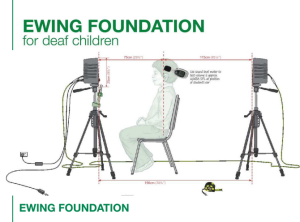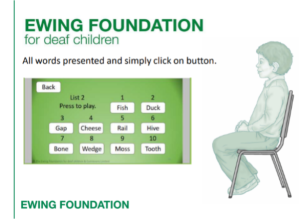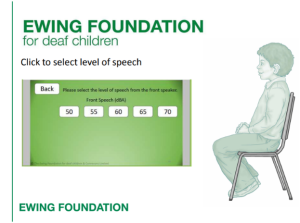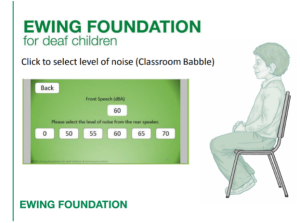5.6. Automated tests

Introduction
Automated test systems have the advantage of consistency and repeatability of presentation. Live voice presentation relies on the speaker keeping their voice at a set intensity level throughout the test. Voice quality and level of presentation may vary when the test is administered by different QToDs.
In an automated test, speech and noise levels can be set and voices are pre-programmed. A sound level meter is key in setting up automated systems to ensure the sound intensity at the listener’s ear is correct. If testing is done in a variety of different settings, room acoustics should be taken into account and may require adjustment of the speaker’s position or sound settings in the system to obtain correct levels at the listener’s ear. Distance measurements should only be a guide and not assumed to give the correct sound intensity. Babble is often used as noise because it has been shown to be the most effective at disrupting speech discrimination (Lewis et al, (1988) cited in American Academy of Audiology, 2011; Shukla et al, 2018).
The disadvantage of automated systems is that they may not represent real-life situations effectively, particularly when testing the benefit of an ALD. Some ALDs are programmed to give priority to live voice and may not process recorded voices as effectively. Positioning of the ALD in relation to the speech speaker is also key in ensuring a good speech signal is picked up and transmitted to the listener. The microphone modes of the ALD also need to be considered to ensure the most effective one is chosen. Speech intensity at the microphone of the ALD should be 80 dBA. The distance between the listener and the speech speaker should be outside the effective range of the listener’s personal hearing device to ensure that ALD has priority in picking up the speech signal, usually greater than 1.5 to 2 m.
Many of the systems available currently are not suitable for assessing the benefit of an ALD due to the close proximity of the speech speaker to the listener. New systems are currently being researched and may be on the market in the near future.
Parrot system
Introduction
The Parrot system consists of a single speaker that is connected via a cable to a handset. The speaker is positioned 75 cm from the listener for the testing and should be level with their ears. Calibration is through 1 kHz narrow band noise and should be 60 dBA at 75 cm from the speaker (measured with a sound level meter). The speaker’s position should be adjusted to achieve the 60 dBA sound intensity. If the system is being used in multiple different rooms, 75 cm should only be used as a guide as room acoustics will affect sound intensity at the listener’s ear. If the system is staying in the same room all the time, the calibration distance can be adjusted and then kept at the same distance each time the test is presented. Speaker stands are not provided with the kit.
Procedure/testing
A range of tests are available for this system:
- McCormick Toy Test
- EAL Toy Test
- AB Short Word List
- Manchester Picture Test
- Manchester Junior Word Test
A different handset is used to administer each test.
Voice presentation intensity can be adjusted in a range of 40 to 80 dB or 30 to 70 dB in 10 dB steps. No background noise is available for this test.
Website: Parrot | Soundbyte Solutions
Considerations for QToDs
This test is useful for assessing speech discrimination at different sound intensities. Speech is presented at a consistent level every time to ensure parity between tests. It is simple to set up and administer. This test is not suitable for testing with an ALD or for assessing how well the listener performs in background noise.
For more information visit the Soundbtye Solution website.
Parrotplus system
Introduction
The Parrotplus system consists of a single speaker that presents both the speech signal and noise. The speaker is placed 75 cm from the listener at ear level. Calibration is through wideband noise and should be at 60 dBA at the listener’s ear, measured with a sound level meter. The speaker position should be adjusted to achieve the 60 dBA sound intensity. If the system is being used in multiple different rooms, 75 cm should only be used as a guide as room acoustics will affect sound intensity at the listener’s ear.
If the system is staying in the same room all the time, the calibration distance can be adjusted and then kept at the same distance each time the test is presented. Speaker stands are not provided with the kit.
Procedure/testing
A range of tests are available for this system:
- McCormick Toy Test
- EAL Toy Test
- AB Short Word List
- Manchester Picture Test
- Manchester Junior Word Test
- CHEAR Consonant Confusion Test (female voice only and wideband noise only)
- CHEAR Auditory Performance Test (female voice only and wideband noise only)
- Ling 6 Sounds
- BKB Sentence Test.
A male or female voice can be chosen for speech presentation unless otherwise stated.
A choice of different background noise is available for most of the tests:
- wideband noise
- adult babble
- classroom babble.
Background noise is presented in short sections with the target word presented in the middle of the noise.
Speech and noise intensity levels can be changed independently. Speech ranges from 30 to 75 dBA in 5 dB steps. Noise ranges from off, then from 30 to 75 dBA in 5 dB steps.
Considerations for QToDs
This test can be used for assessing speech discrimination at varying levels of speech and in varying levels of background noise. It can be used to assess the speech-to-noise ratio (SNR) that is needed for the listener to discriminate speech.
This system is simple to set up and provides consistent levels of speech and noise ensuring repeatability between tests. Regional accents can be added. Polish and Slavic speakers can be added for McCormick and EAL tests.
This test presents background noise in short sections, which are not long enough for modern digital hearing devices to sample and adjust to (they need a minimum of 15 seconds). This means the personal hearing device may not be working optimally during the test. As the speech and noise are presented from the same speaker and the speaker is within the effective range of the listener’s personal listening device, this test is not recommended for testing the benefit of an ALD.
ParrotPlus description.
For more information visit the Soundbyte Solutions website.
Parrotplus 2
Introduction
The Parrotplus 2 system consists of two speakers: one that presents a speech signal and one that presents background noise (see Fig 1). The speech signal speaker is placed 75 cm in front of the listener and the noise speaker 75 cm behind the listener. Both speakers should be at ear level. Calibration is through wideband noise and should be at 60 dBA at the listener’s ear measured with a sound level meter for both the speech and noise speakers. The speaker positions should be adjusted to achieve the 60 dBA sound intensity. If the system is being used in multiple different rooms, 75 cm should only be used as a guide as room acoustics will affect sound intensity at the listener’s ear.
If the system is staying in the same room all the time, the calibration distance can be adjusted and then kept at the same distance each time the test is presented. Speaker stands are not provided with the kit.
Figure 1: Parrotplus 2 speaker position.
Procedure/testing
The Parrotplus 2 is the same as the Parrotplus in terms of tests available, choices of noise, and the option of male or female voices.
Considerations for QToDs
This test is useful for assessing speech discrimination at varying levels of speech and in varying levels of background noise. It can be used to assess the SNR that is needed for the listener to discriminate speech. This system is simple to set up and provides consistent levels of speech and noise ensuring repeatability between tests. Regional accents can be added. Polish and Slavic speakers can be added for McCormick and EAL tests.
This test also presents background noise in short sections, which are not long enough for modern digital hearing devices to sample and adjust to (they need a minimum of 15 seconds). This means the personal hearing device may not be working optimally during the test. A noise cube can be used instead which presents background noise continuously and is available from Soundbyte Solutions. Historically, this test has been used to test the benefit of ALD; however, the speech speaker is within the effective range of most personal hearing devices, and it is therefore difficult to tell whether the ALD is giving benefit or whether the hearing device is picking up the speech signal. It is therefore not recommended for testing ALD benefit.
Noise Cube Soundbyte Solutions website
Ewing Foundation Speech-in-Noise (SiN) Toolkit
Introduction
This test kit was developed by the Ewing Foundation in collaboration with Connevans and sold through the Connevans website. It consists of two speakers: one that presents a speech signal and one that presents background noise (see Figure 3). The speech signal speaker is placed 75cm in front of the listener and the noise speaker 75cm behind the listener. Both speakers should be at ear level.
The speech signal speaker is placed 75cm in front of the listener and the noise speaker at 115cm behind the listener with the speakers at ear level. The sound intensity should be 60 dBA at the listener’s ears for both speech and noise. The speaker positions or sound output level should be adjusted to achieve the 60 dBA sound intensity. The distance measurements should only be used a guide if the system is being used in multiple different rooms as room acoustics will affect sound intensity at the listener’s ear. If the system is staying in the same room all the time, the calibration distance can be adjusted and then kept at the same distance each time the test is presented. Speaker stands are provided as part of the kit.

Figure 2: Speech-in-Noise (SiN) Toolkit speaker position (picture from BATOD).
Procedure/testing
A range of tests are available with this toolkit:
- AB Short Word List
- Manchester Junior Word List
- Manchester Picture Test.
The test is provided on a flash drive so that the software can be installed on a device of the user’s choosing, eg, laptop, iPad, phone.
A male or female voice can be chosen. The words for the tests are presented on the screen and the chosen word is played by clicking on it (see Figure 3). Speech and background noise intensity can be set independently at differing levels (see Fig 5) and both increase in 5 dB steps.

Figure 3: Words presented on screen for the chosen test (picture from BATOD).


Figure 4: Speech and noise intensity can be set independently of each other (pictures from BATOD).
Considerations for QToDs
This test can be used for assessment of speech discrimination at varying levels of speech and background noise. It can be used to assess the SNR needed for the listener to discriminate speech. This system is simple to set up and provides consistent levels of speech and noise ensuring repeatability between tests. Everything is provided in the toolkit including speaker stands and a sound level meter. The test can be installed on a variety of devices, eg a laptop or tablet.
As the speech-producing speaker is within the effective range of the listener’s personal hearing device, it is recommended in the instructions to place the ALD 25 cm below the top of the speaker, which should give a 10 dBA advantage through the ALD.
The SiN Toolkit is currently out of production due to a lack of uptake. If there is demand, it may be re-released.
References:
Lewis, H., Benignus, V., Muller, K., Malott, C., Barton, C. (1988) ‘Babble and random-noise masking of speech in high and low context conditions’. Journal of Speech and Hearing Research, Volume 31 pp.108–114 cited in American Academy of Audiology (2011) ‘American Academy of Audiology Clinical Practice Guidelines Remote Microphone Hearing Assistance Technologies for Children and Youth from Birth to 21 Years (Includes Supplement A)’. Available at from the American Academy of Audiology.
For more information available on the Ewing Foundation website
Sound files for SiN
Phoenix
This section is still under development.
For more information: https://www.soundbytesolutions.co.uk/products/phoenix/
Next pages in this section
5.7 Parent/guardian reports (under construction)
5.8 Teacher reports (under construction)
5.9 Children and young people reports (under construction)
Previous pages in this section
5.5 Sentence testing
Other sections
- Section 1 Anatomy and physiology of the ear
- Section 2 Aetiology and types of deafness
- Section 3 Auditory perception and hearing testing
- Section 4 Acoustics and physics of sound
- Section 6 Hearing technologies




